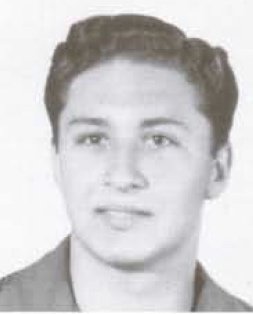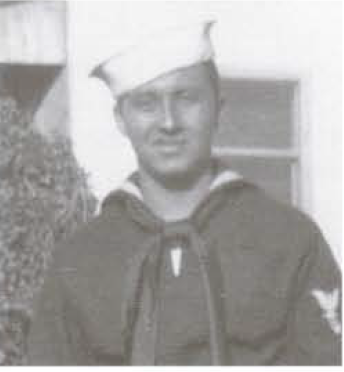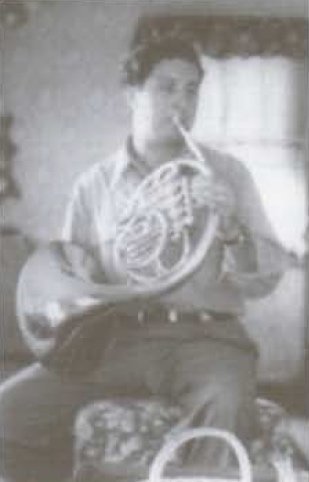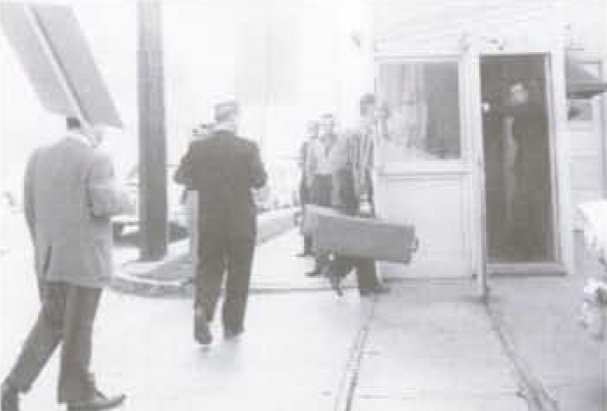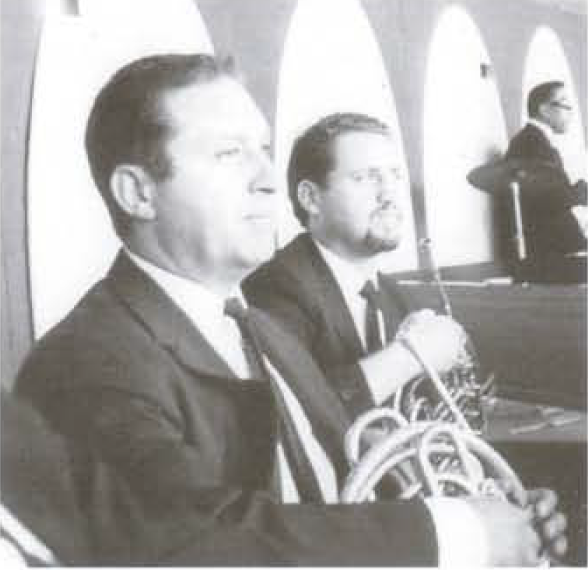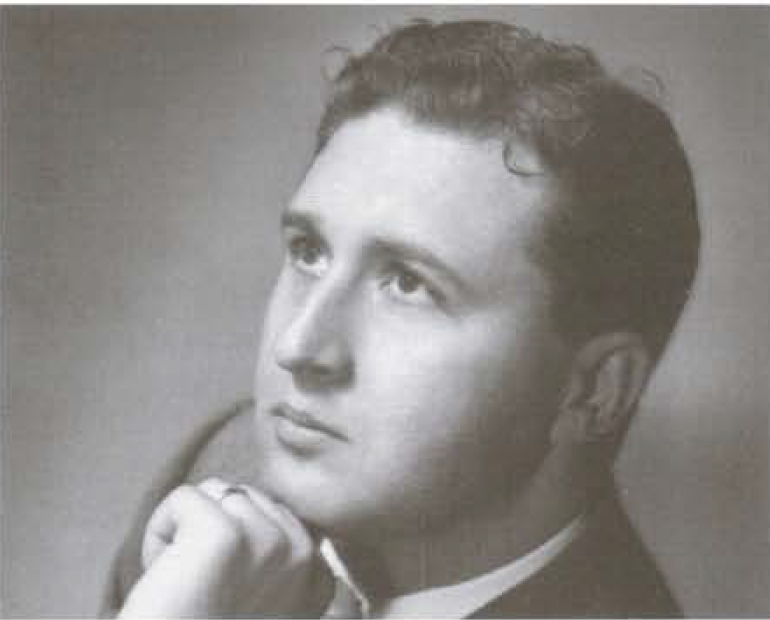The Robinson Brothers
by: Annie Bosler, DMA for the International Horn Society’s The Horn Call (February 2007, pages 47-49)
The Robinson brothers, Gale and Alan, have been an important part of a music scene that has emerged within the last eighty years - the Los Angeles studios. Within the last year, the world of film music mourned the loss of Gale Robinson, but his brother Alan still survives as one of the eight remain,ng horn players from the early era of mm music. Between the two brothers, Alan and Cale recorded close to 100 albums with leading popular musicians and are heard on the soundh·acks of over 500 movies.
Considering that the occupation of a film studio musician is not even a century old, history is literally in the making. An entire genre of recorded music began in 1927 with Warner Brothers' movie The Jazz Singer. Other studios soon followed suit, recording soundh·acks and synchronizing them with pictures.
By the 1950's, the studios (MGM, 20th Century-Fox, Warner Brothers, Paramount, Columbia, RKO Radio Pictures, Republic Productions, and Universal) employed about 500 contracted musicians, including 36 full-time contracted horn players. Of the original horn players from the 1930's and early 1940's, Alan Robinson, Vince DeRosa, James Decker, George Hyde, Fred Fox, Richard Perissi, Gene Sherry, and James McGee are still living.
Gale's Start as a Horn Player
A Young Gale Robinson
Gale Robinson begru1 studying horn in 1938 at age 13 with Charles Peele. Gale said, "I seemed to have an aptitude for [the horn] because ... I could play the range of the instrwnent in six weeks." When Gale was 15, the conductor of the Los Angeles Philharmonic, Leopold Stokowski, formed the National Youth Administration (NYA) orchesh·a as part of the Works Progress Administration. Gale laughed and said, "I had been on the track team and I had pulled a ligament, so when l went in to audition, I went in on crutches." Gale was waiting outside to hear the results of the audition for the NYA orchestra when Stokowski pointed at him and said, "You, my first horn." Stokowski introduced Gale to James Stagliano and Alfred Brain, the top two Los Angeles horn players of the time. Gale said, "l got some help from some very big people, and that is how I broke into the business."
Gale's first break into the studio scene came in 1941, when he played for the Disney movie Bambi. He was 16 years old. Over the next two years, Gale was often excused from high school to play recording dates. These included John Wayne westerns at Republic Studios, Alfred Hitchcock pictures at Universal, and several Lux Radio Theatre shows. Gale said, "I was always taught when I was a young kid that if you are a good horn player, you will always make a living. That is what I believed.”
The War Years
Gale in the Merchant Marines
As Gale's studio career was beginning to take off, the rest of the world was entering WWll. Gale was planning to enlisl after high school. "ln the back of all of our minds," he said, "that is what we were thinking." Many musicians were drafted during the war, but the majority of them played in bands rather than fighting. Upon high school graduation, Gale entered the Merchant Marine Band for three months on Catalina Island (just off the coast of Los Angeles.) Also in the band were big band musicians who played for Tommy Dorsey, Harry James, and Glen Miller. Gale recalled, "These were the guys that were on the merchant ships...many of them were losing their lives with the Uboat attacks. l felt guilty being in a band...I felt like f was dodging something. I put in a request to leave the Merchant Marines to join the Navy as a serunan. I ended up on a battle ship and it was the end of my horn playing [until after the war]." ln 1943 Gale entered the Navy and stayed for almost three years. He fought in seven major battles, encountered over 300 air attacks, and received the Purple Heart when he was wounded by shrapnel.
Just before the end of the war, Gale transferred back to play in a band at NBC studios doing command performances. Referring to those days, Gale said, "I was shot, literally shot. My nerves were shot." After the war, Gale signed a contract with MGM for two and a half years, but left MGM before the contract was over to do more live work with the Los Angeles Philharmonic. Gale played in the orchestra for six years, w1til the mid 1950s when he signed on with Paramount Studios.
Family History
Alan (left) and Gale as young boys
Both Robinson brothers were born in the same French hospital in d1inatown, north of downtown Los Angeles. Gale was born on December 7, 1924, and Alan on November 26, 1929. They grew up in an area known as Gopher's Flats and attended the same grammar school, junior high school, and high school.
Both brothers learned to read music at an early age because their mother was a pianist. They listened to recordings of the New York Philharmonic, Detroit Symphony, CBS Orchestra, and Philadelphia Orchestra. They both thought that Bruno Jaenecke, the first horn of the New York Philharmonic, was "a god." Surprisingly, Alan never had a horn teacher. He learned from Gale. "Gale was always the big brother...but no nepotism was ever involved," Alan said. Gale played mostly classical music, while Alan eventually became more of a jazz performer.
Alan’s Start as a Horn Player
While Gale was away at war Alan learned to play the horn. Five years younger than Gale, Alan was playing clarinet and oboe in the junior high school band. When the music teacher asked, "Can you get a French horn?" Alan replied, "'Well, my brother has one in the closet…So I picked the lock, took the horn, and I started playing in the orchestra in junior high school. I loved the French horn."
During junjor high school, Alan's parents gave him five cents each day to take the bus. One morning, Alan decided to save his five cents and hitchhike. "I stood," he recounted, "on Riverside Drive with my thumb out and this big semi truck stopped…it was slightly raining, if I remember right. I got way up in the cab with my brother's horn, a Kruspe compensating model, and the case opened up, the horn fell on the ground…a car was making a right turn, and it rolled right over the horn and went off! Oh, I was devastated." Since Gale was coming home from overseas in about two weeks, Alan took the horn to a local repairman with some Scotch as a payment. When Gale came home, he never noticed that there was damage to the horn and began playing it in the studios. Alan continued, "I was at a party once…and I was telling somebody the story. I didn't know that Gale was standing behind me…he heard the story…and got completely mad at me. And it was thirty years after I did it!"
Alan’s Early Professional Life
Alan was thirteen years old when he started playing in a local Los Angeles Youth Orchestra conducted by Pyotr Merenbloom. When a movie called for young musicians, Merenbloom's youth orchestra was used "on-screen", so the first picture Alan played was the movie Humoresque in 1946. In 1948 Alan began attending the Los Angeles City College, with a major in geology and a minor in psychology. "Music was my life," he says of his choice of study subjects, "I knew all about music, so I wanted to learn about other things."
Alan in his youth
While Alan was still in college, he won the third horn position with the Utah Symphony. At the same time, he was offered the principal chair in the Honolulu Symphony, but opted to move to Utah because of his interest in skiing. Alan performed with the Utah Symphony for three years before returnjng to L.A. to play in Alfred Newman's studio orchestra at 20th Century Fox. He was the youngest contract musician in the studio, playing second horn to Alfred Brain, the uncle of Dennis Brain. Alan continued to play in the section when Los Angeles legend Vince DeRosa took over as first horn.
Although Alan did many classically-based performances early in his career, his niche would become playing jazz and "pop" albums with many of the top recording artists of his day. Starting in the 1950's (and continuing well into the 1980's), Alan traveled back and forth between Las Vegas and Los Angeles to perform with leading artists. Among others, Alan played solo horn with the Beach Boys, Barbara Streisand, Dizzy Gillespie, Peggy Lee, Judy Garland, Frank Sinatra, Elton John, Paul McCartney, Glen Campbell, The Carpenters, and Earth, Wind, and Fire. Alan's movie list from the 1950's at 20th Century Fox includes The King and I, Carousel, Spartacus, and The Sound of Music. Alan finally left 20th Century Fox in 1958.
The Strike of 1958
Photo of the 1958 Strike
The year 1958 brought turmoil to the Los Angeles film industry when the musicians went on strike. Gale recalled that the musicians' strike occurred for two reasons: first, the studios decided not to renew contracts. Second, the President of the American Federation of Musicians (AFM), James C. Petrillo, did not support recording of music or residuals (money paid to musicians for the re-use of recorded music). Petrillo tried to argue that studio recordings would be the end of live music. Because of Petrillo's adversity toward them, many musicians decided to break away from the AFM and form their own union, the Musicians' Guild of America. The Robinson brothers stayed with theAFM.
When the contracts ended in 1958, musicians who sided with the AFM could only do live work, while musicians who sided with the Musicians' Guild of America could only record. Alan became a house painter and real estate agent; Gale went to work in a photography shop. Gale said, "I only did the photography for about two months, and then all of a sudden they started calling us back and work started again…It was a divided time, with a lot of tension…The strings were for the AFM and the winds and brass were for the Guild." By September, contract orchestras were extinct. Studio freelancing became a Los Angeles musician's way of life. Gale and Alan Robinson both preferred contracted work to freelance, and a large division formed between horn players because of the differences of opinion.
Gale during the strike
The Freelance Era
Gale (left) and Alan performing together
The era of freelance allowed musicians a more flexible schedule where gigs were per service and there were no quotas (that is, restrictions on how many hours a musician could work per week). Gale and Alan took advantage of this early decade of freelance to play in other parts of the world. ln 1958, directly after the contracts ended, Alan toured with the National Orchestra of Mexico, where he played principal on Shostakovich's Symphony No. 5 39 times. Between 1962 and 1965, Gale played for three seasons as principal horn with the Pittsburgh Symphony Orchestra (turning down the position of first horn in Chicago). Under conductor William Steinberg and the PSO, Gale recorded Tchaikovsky's Symphony No. 4, Mahler's Symphony No. 1, and all but the Ninth of the Beethoven Symphonies. After playing with Zubin Mehta in the Los Angeles Philharmonic, Alan joined Gale for the Pittsburgh Symphony's tour of Europe in the swnmer of 1964.
ln the years following the resolution of the strike, freelance studio work became the staple income for the Robinson brothers. For Gale these titles include Lord of the Rings, Indiana Jones and the Temple of Doom, Summer and Smoke, Rocky, and the TV show The Simpsons. Alan performed on TV series for both The Waltons and Starsky and Hutch, and his movies include The Muppet Movie, Star Trek I, and To Kill a Mockingbird. The brothers performed together in nearly 100 films, including The Ten Commandments, Close Encounters of the Third Kind, and The Godfather. Alan's last studio session was in the early 1980's for television, and Gale ended his recording career at the age of 78 in 2002 with the TV show The Simpsons.
Conclusion
The phenomenal contributions of Gale and Alan Robinson have scarcely been noticed by the world of music. Because of the lack of credit given to recording musicians on and off the screen, their names are virtually unknown. One glance at the seemingly endless lists of recordings by the Robinsons attests to their tremendous influence in the genre of recorded music. History is made every day in Los Angeles, but most of these musicians remain anonymous - invisible people whom we can hear but not see. Gale Robinson passed away on February 16, 2006. Although he is gone, his music and the music of his brother Alan survives. In the City of Angels, the music of horn players will forever soar.
Gale (left) and Alan Robinson in 2005
Gale Robinson (1925-2006)

